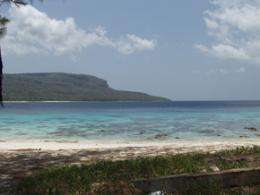Gone fishing? We have for 42,000 years

(�鶹��ԺOrg.com) -- An archaeologist from The Australian National University has uncovered the world’s oldest evidence of deep sea fishing for big fish, showing that 42,000 years ago our regional ancestors had mastered one of our nation’s favourite pastimes.
Professor Sue O’Connor of the College of Asia and the Pacific at ANU, also found the world’s earliest recorded fish hook in her excavations at a site in East Timor. The results of this work are published in the latest issue of Science.
The finds from the Jerimalai cave site demonstrate that 42,000 years ago our regional ancestors had high-level maritime skills, and by implication the technology needed to make the ocean crossings to reach Australia.
“The site that we studied featured more than 38,000 fish bones from 2,843 individual fish dating back 42,000 years,” said Professor O’Connor.
“What the site in East Timor has shown us is that early modern humans in Island Southeast Asia had amazingly advanced maritime skills. They were expert at catching the types of fish that would be challenging even today – fish like tuna. It’s a very exciting find.”
Professor O’Connor also uncovered the world’s oldest fish hook, which dates from a later period.
“We found a fish hook, made from a shell, which dates to between 23,000 and 16,000 years ago. This is, we believe, the earliest known example of a fish hook and shows that our ancestors were skilled crafts people as well as fishers. The hooks don’t seem suitable for pelagic fishing, but it is possible that other types of hooks were being made at the same time.”
What’s still unknown is how these ancient people were able to catch these fast-moving deep-ocean fish.
“It’s not clear what method the occupants of Jerimalai used to capture the pelagic fish or even the shallow water species. But tuna can be caught in purse seines or leader nets, or by using hooks and trolling. Simple fish aggregating devices such as tethered logs can also be used to attract them. So they may have been caught using hooks or nets. Either way it seems certain that these people were using quite sophisticated technology and watercraft to fish offshore,” said Professor O’Connor.
She added that this may shed light on how Australia’s first inhabitants arrived on the continent.
“We have known for a long time that Australia’s ancient ancestors must have been able to travel hundreds of kilometres by sea because they reached Australia by at least 50,000 years ago. We also know that they used boats because Australia was separated from Southeast Asia by ocean throughout the human time span. When we look at the watercraft that Indigenous Australians used at the time of European contact, however, they are all very simple, like rafts and canoes. So how people got here at such an early date has always been puzzling. These new finds from Jerimalai cave go a long way to solving the puzzle,” said Professor O’Connor.
Provided by Australian National University
















